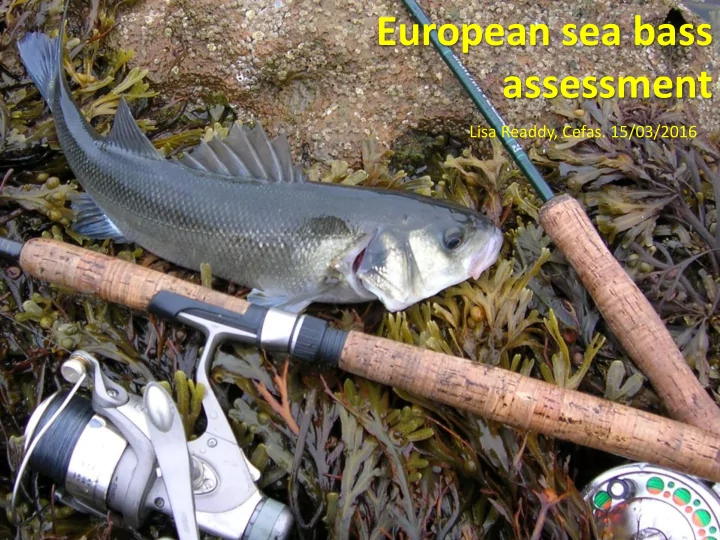

European sea bass assessment Lisa Readdy, Cefas. 15/03/2016
- What do we know about Bass - History of the bass fishery - Recent and future developments
Bass, what do we know?
Sea bass stock structure: current thinking Four stock assessment areas identified: Do fisheries in one area affect future catches in another area?
Less information available on French nursery areas.
Longer term trends in recruitment and sea temperature Cold winter temperatures can lead to high mortality of 0-gp and 1-gp bass. Warmer period from 1989 to early 2000s coincides with stronger recruitment. Some recent winters have been cold - recruitment appears low. (2013 assessment – provisional; coastal temperatures from Cefas website)
Development of area IV-VII commercial fishery. Landings increased in all areas following 1989 year class and subsequent good recruitment. Bulk of catch is by France
Discarding of sea bass in IV & VII: mainly MLS driven % discarded greatest for UK and French otter trawls (~ 12% by weight) Other gears very low discard rates < 1 or 2% typically Discarding by otter trawls largest near important nursery grounds e.g. in VIId Could be improved through more selective gears and spatial management measures.
Recreational bass fishing: recent survey estimates International recreational fishery removals in IV+VII (mainly angling): Estimated to be around 20% of total fishery removals Recreational fisheries information required through EU regulations (Data collection framework) Data for England recently collected by Sea Angling 2012 is contributing to this along with France and the Netherlands. UK conducting another survey under the EU data collection.
Recent developments
Stock trends in area IV & VII: ICES WGCSE2015 results Fishing pressure Stock size 2012 2013 2014 2013 2014 2015 MSY Maximum F MSY Above Below trigger Sustainable Yield B trigger Precautionary F pa , Undefined B pa , B lim Increased risk approach F lim Management - - - - F MGT - - Not applicable SSB MGT Not applicable plan Strong year classes caused a rapid increase in spawning-stock biomass (SSB). The fishing mortality (F) shows an increasing trend and is well above the F MSY proxy. Recruitment has been very poor since 2008. SSB has been declining since 2010 and is now below MSY B trigger .
ICES advises that when the MSY approach is applied, total landings (commercial and recreational) in 2016 should be no more than 541 tonnes. ICES cannot quantify the corresponding catches. ICES advises that a management plan is urgently needed to develop and implement measures to substantially reduce fishing mortality throughout the range of the stock.
On 16 December the Member States adopted the following measures: • In the first half of 2016: • No fishing for sea bass by commercial vessels targeting sea bass • Except long lines, pole and lines and set nets who will have a closure of two months in February and March 2016 • a small by catch allowance of 1% is envisaged for demersal trawlers and seiners per vessels per month to cover unavoidable by-catches. • Recreational anglers may practise a catch and release fishery. • In the second half of 2016: • catch limits for commercial vessels and no more than 1 fish per fisherman per day for recreational anglers. • A continued area closure around Ireland for commercial fishing. • Minimum landings size 42 cm
• Future research and developments. • IBPBass2 completed by 30 March 2016 • Defra study program in support of the conservation of Sea Bass. • Continuation of standard data collections. • Seabass full benchmark provisionally planned for 2017
Main issues. - Vulnerable due to slow growth and relatively late maturity . - Bass fisheries have expanded over time . - Commercial and recreational fisheries share the resource. - Management has been largely by technical measures (e.g. MLS; bass nursery areas). Commercial ban in Ireland. - Potential to become a choke species for vessels operating within a mixed fishery.
Recommend
More recommend